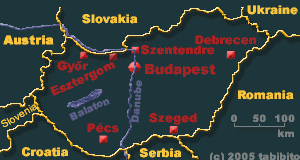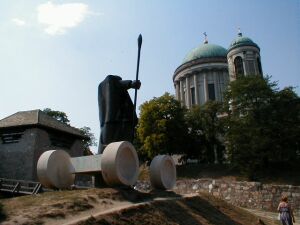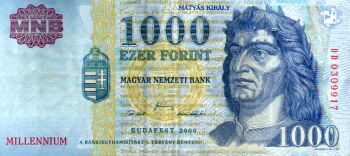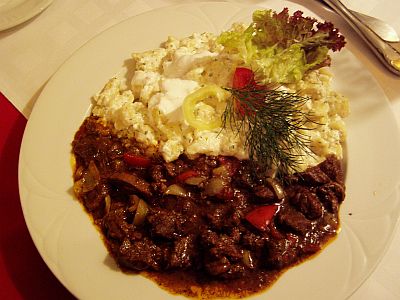|
|
|
|
|
|
 Official name:
Magyarköztársaság
(Republic of Hungary). The short version of this is Magyarorszag, which means
Land of the Magyars (name of a tribe). More common is the English form Hungary or
similar words as for example Ungarn in German etc.
Area: 93,030 km² - 2/3 of the size of England and as big as Indiana.
Population: slightly more than 10 million* (2003) -
almost the same is London Metropolitan Area.
Ethnic groups:
Almost 90% are ethnic Hungarians. Minorities incl. Roma (4%, est.), Germans (2.6%), Serbs (2%), Slovaks (0.8%)
Romanians (0.7%) and others. There's a remarkably large Hungarian community living abroad. *
Religion:
Around 2/3 are Roman-Catholic, some 20% Calvinists, 5% Protestants and others*
Time zone: As in middle Europe: GMT +01 hr, with daylight-saving time (+1 hour) in summer.
Language: Hungarian (Magyar). This language belongs to the
Finno-Ugric language group, namely a branch of the Uralo-Altaic language family.
This means, that Hungarian has absolutely nothing to do with Indo-European languages such as English, German, Spanish etc. Which is
bad news for the traveler. As a matter of fact, Hungarian is an agglutinative language, ie parts of words are
combined into long sequences to form sentences. Other languages belonging to the same language family (distantly!) include
Finnish, →Turkish and
according, to some theories, →Japanese as well as
→Korean.
Official name:
Magyarköztársaság
(Republic of Hungary). The short version of this is Magyarorszag, which means
Land of the Magyars (name of a tribe). More common is the English form Hungary or
similar words as for example Ungarn in German etc.
Area: 93,030 km² - 2/3 of the size of England and as big as Indiana.
Population: slightly more than 10 million* (2003) -
almost the same is London Metropolitan Area.
Ethnic groups:
Almost 90% are ethnic Hungarians. Minorities incl. Roma (4%, est.), Germans (2.6%), Serbs (2%), Slovaks (0.8%)
Romanians (0.7%) and others. There's a remarkably large Hungarian community living abroad. *
Religion:
Around 2/3 are Roman-Catholic, some 20% Calvinists, 5% Protestants and others*
Time zone: As in middle Europe: GMT +01 hr, with daylight-saving time (+1 hour) in summer.
Language: Hungarian (Magyar). This language belongs to the
Finno-Ugric language group, namely a branch of the Uralo-Altaic language family.
This means, that Hungarian has absolutely nothing to do with Indo-European languages such as English, German, Spanish etc. Which is
bad news for the traveler. As a matter of fact, Hungarian is an agglutinative language, ie parts of words are
combined into long sequences to form sentences. Other languages belonging to the same language family (distantly!) include
Finnish, →Turkish and
according, to some theories, →Japanese as well as
→Korean.
The Hungarian language features distinctive gimmicks such as the so-called
vowel harmony. This means, that endings correspond with the syllables standing in front of the ending. It includes certain
pronunciation patterns, which are difficult to learn (interestingly, Slovakian - a Slaviv language, which was heavily influenced by Hungarian - has
something similar). However, note that the author of this website doesn't really have a clue about Hungarian.
The good news is that Latin script is used. Unfortunately, the pronunciation is often completely different. Additionally, there
are some consonant combinations counting as single sounds. Which means, that for example cs- counts as a
single letter. Therefore, words or names starting with 'cs' are not written between c and cytries in dictionaries, phone books etc, but after the letter c.
Eg, first comes 'c-' to 'cy-', then 'csa-' and so on. Therefore I want to provide a short overview of typical Hungarian consonants and combinations:

- C is always pronounced as the [ ts ] in [ tsar ]
- Cs is pronounced as the [ ch ] in [ coach ]
- Gy is pronounced as the [ dy ] in [ Goodyear ]
- J and Ly are both pronounced as the [ y ] in [ yes ]
- ny is pronounced as the Spanish [ ñ ] in [ cañon ]
- S is always pronounced as the [ sh ] in [ ship ] (!!!)
- Sz is pronounced as the [ s ] in [ sing ]
- Ty is pronounced as the [ tu ] in [ tune ]
- Zs is pronounced as a voiced 'sh', ie as the [ s ] in [ vision ]
.
Of course, Hungarian doesn't only consist of consonants. As with the vowels, it's absolutely necessary to be aware of
the accents, ie small marks atop the vowels:
- a
is mostly pronounced as the open [ o ] in [ god ], á on the other hand
is pronounced as the [ a ] in [ arm ], but shorter.
- e Is pronounced as a short [ e ], as for example in [ get ].
é is a long [ e ] as for example the [é] in [ café ].
- i is a short [ i ] as in [ fit ]. Therefore, í
is a long [ i ] as the [ ee ] in [ meet ].
- o is a short [ o ] as the [ o ] in [ north ] (but shorter!),
ó is similar to the [ o ] in [ north ].
- ö
is similar to the German o-umlaut, close to the [u] in [ fur ] but shorter, ő
(o with two long diagonal strokes) is the long version of [ ö ]. Since many computers cannot
display this character, it is often written as [ õ ].
- u is pronounced as a short [ u ] - close to the [ oo ] in [ foot ]. Hence,
ú is pronounced as the [ oo ] in [ food ].
- ü is similar to the German u-umlaut, close to the
French [ u ] as in [ parvenu ]. Logically, ű is the long form of it.
The latter is not often used in Hungarian.
Especially the umlauts are excessively used. Knowing the correct pronounciation is
extremely helpful - how else would it be possible to get a train ticket to →Pecs
for example when you don't know that it's pronounced [ pairch ]? Hungarians are used to
the wrong pronounciation of [ Budapest ] (correct: Budapesht), but in the countryside it might get difficult.
Many Hungarians speak English very well. But not seldomly it's only German
that can help you.
|
|
|
|
|
|
|
Hungary lies in the centre of Europe, north of the large Balkan peninsula. Which means, that it's
far away from the Sea. A large part of the country is located in the Carpathian Basin.
From north to south, the long Duna (Danube) river crosses the country. Other
major rivers include the Tisza, Rába and Dráva - all of them are tributaries of the
Danube. The Danube divides the country into a western part and the larger eastern part. The latter is dominated by the
famous Nagyalföld (Puszta) - a vast plain. The western part features hilly areas. This region is
called Dunántúl (Transdanubia). Mountains are rare in Hungary. The one and only
mountainous area is called Matra mountains some dozen kilometres north-east of
→Budapest. There, the 1014 m high Kékes
marks the highest peak of the country.
There might be a lack of mountains, but not of lakes. The biggest lake is the Balaton-tó (tó = lake),
which is quite famous and extremely shallow. Furthermore, Hungary offers countless thermal springs, well-known for
their therapeutical effects.
|
|
|
|
|
|
|
Present-day Hungary was probably first inhabited by Celtic tribes, but later on the
Celts were driven out by the Romans some 2000 years ago. Than, the area west of the river Danube became the
Roman province Pannonia. This shouldn't change until the year 451, when Attila and the Huns
invaded the region and founded a short-lived Hun Empire. Later on, Goths, Lombards and Avars successively
conquered the region. During the 9th century, several Magyar tribes (pronounced Muja-r),
coming from the area between the Ural mountains and the Volga, settled in the Danube Basin. Shortly after they'd arrived, they became
infamous throughout Europe. The Magyars terrorized not only the neighbouring regions but even Spain, Germany, Italy etc.
Their raids were brutal und unpredictable, leaving wide areas devastated. This came to an end in 955, when the Magyars
were defeated in the decisive Battle of Augsburg. Consequently, the Magyars were christianized. In the year
1000 (finally a date in history which is easy to remember!) István aka Stefan I founded the First
Hungarian Empire.
In the year 1241, Hungary was overrun by another nomadic tribe - the Mongols devastated the entire empire.
Historians estimate that one third of the Hungarians didn't survive the raid. In medieval times, Hungary started to grow stronger again.
And it was much bigger than it is today - →Transylvania, present-day
→Croatia as well as →Slovakia
belonged to the Kingdom of Hungary. In 1222, the first European Golden Bull was ratified. The Golden Bull
limited the king's power in favour of the noblemen. The bull was enacted in the small town Székesfehérvár.
In 1367, the first Hungarian university was founded in →Pécs.
The Hungarians managed to stop the Ottoman invasion of the Balkans near →Belgrade in 1456. Unfortunately,
peasant uprisings, led by Dózsa (who, by the way, was later executed on a red-hot iron throne) weakened
the kingdom, and so the Ottomans were successful in their next attempt to conquer the Balkans and Hungary. The final battle was fought in 1526
in Mohács (not far from Pécs). In the year 1541, the Ottomans conquered the fortress of Buda.
The Hungarian kingdom was divided into three parts. →Slovakia and Transdanubia
became a part of the Austrian Habsburg monarchy; the central part was reigned by the Ottoman empire and Transylvania
(present-day central Romania) became a vassal of the Ottomans.

| |
Esztergom - for a long time the capital of Hungary
|
In 1920, a short-lived communist government was swept away in a bloody coup led by the rightest Admiral Miklós Horthy.
Horthy remained in power for the next decades. In 1941, he collaborated with Nazi-Germany. And so Hungary provided military support for
Germany. In 1944, Horthy made a U-turn and tried to quit the alliance, but the Nazis immediately removed him from power. Instead of him, the
infamous, fascist Arrow Cross movement gained power and soon started to expel all Hungarian Jews. Needless to say that
almost all Jews were sent to German concentration camps and fell victim to the shoah. The Red Army had its difficulties in
invading Hungary - the entire country was not liberated before April 1945.
Hungary was liberated by the Soviet Union, and so it was within the Soviet sphere of influence, ie it was ruled by a communist
government. On October 23 in 1956, students initiated an uprising against the 'occupation'. The leaders didn't hesitate to open fire on
the unarmed demonstrators. But the uprising was too big to be put down immediately. Imre Nagy, leader of the opposition,
gained power and granted a general amnesty for all political prisoners on October 28.
Street fights erupted, and many members of the Secret Service AVO were hunted down and massacred.
The Red Army first retreated and observed the protests from a distance, but when Imre Nagy declared that Hungary would leave
the Warsaw Treaty (the communist counterpart of the NATO), Moscow decided to intervene. The Red Army marched on
→Budapest to put an end to the uprising. Some 3,000 people were killed; hundred thousands fled to
Austria. Hungary became a communist-ruled country again, but in the year 1968, the typical central economic control system was
replaced by a limited market system. The socialist János Kádár remained in power
until 1987. He was replaced by Károly Grósz, who gradually reformed the country.
In 1989, the communists gave up their monopoly on governmental power of their own free will and so they gave way to the first free election.
During a so-called "European Picnic" in Sopron in 1989, the border to Austria was opened for a few hours.
This was even announced before via flyers handed out to East German tourists. And so thousands of East Germans used their chance and
fled to West Germany via Austria (I was there at that time as well...when me and my parents went back to East Germany, some border guards
greeted us friendly - they were probably lucky to have at least some of their citizens back).
After that, the government changed quite often. Switching to a free market economy was quite painful. But compared to other
East European countries, Hungary is quite successful and shows great potential. In 1999, Hungary became a member of the NATO. In 2004,
Hungary eventually gained full EU membership.
|
|
|
|
|
|
|
Prologue:
Many people will agree that Hungary is simply a must-see in Europe. Unfortunately, many visitors
see little more than Budapest and Lake Balaton. Indeed - there are no real mountains and there's no coastline.
On the other hand, the country offers highly interesting cultivated landscapes, many sights, excellent
food (not to forget the drinks) and more. I've been to Hungary four times, but I can't get enough of it....
By the way, my personal favourite in Hungary is definitely the old city of →Pécs.
Visa: Most nationalities do not require a visa.
A valid passport is everything you need. A glorious exception is Australia -
but rumours say that this might change in the near future. Usually, there's also no hassle at the border.
Money: The Hungarian currency is called
Forint (abbr. ft). 1 ft = 100 Filler, but due to the low value, Filler are not
in use any longer.

| |
Hungarian 1,000 Forint bill
|
There is no lack of ATM's in the cities, accepting common credit cards and
Maestro, Cirrus (formerly EC) etc cash cards. The usual fee per transaction is € 4. Cash can be exchanged everywhere.
Many hotels also accept Euro and USD.
There are 1, 2, 5, 10, 20, 50 and 100 ft coins and 200, 500, 1000, 2000, 5000 and 10,000 ft banknotes.
Costs: Hungary offers everything you can also find
in Western Europe, but prices are substantially cheaper. It's no problem to find a bed for a night
for € 10; eating out in restaurants is quite cheap as well. The same can be said about
train and bus tickets. Costs for travelers can be compared to those of the
→Czech Republic - which means that
it's possible to get by on as little as € 20 a day, but it's no problem to spend much more - depending
on the style of traveling. However, travelers coming from the neighbouring countries
→Romania, →Serbia, not to
talk about the →Ukraine, will soon complain about
the high prices in Hungary. It goes without saying that Budapest and the area around Lake Balaton are much
more expensive than the rest of the country.
Transportation inside the country is comparatively cheap, but international trains
can be really expensive. There's a weird discount system - return tickets for trains are often cheaper
than a single ticket. It's definitely a good idea to check for discounts (student, return etc) before
purchasing long-distance train tickets.
Getting there: You can get to Hungary by bus, train, plane, car or
by boat. Yes, boat. And - except for the Ukraine - most nationalities (sorry Aussies) do not require a visa for
the neighbouring countries, so it's easy to move in and out freely. There are
direct flights to Hungary from every major European city.
The national carrier is called Malev, but many other airlines operate
flights to and from Hungary as well. Since Hungary is not a very big country and Budapest lies in the
centre of it, almost all flights go to Budapest.
There are many international bus connections from Middle Europe to Hungary.
Many of those buses go ahead to →Serbia,
→Romania, →Bulgaria
and even as far as →Turkey.
Of course buses are not the most convenient way to get there.
The connection with the European railway network is excellent. Many international trains
go to or pass Budapest. Note that there are three important train stations in Budapest - Keleti pu. (East terminal),
Nyugati pu. (West terminal) and Déli pu. (South terminal) - "pu." stands
for Pályaudvar (train station). Hence, it's a good idea to
read timetables carefully to understand, where the trains are running to or starting from.
Anyway, all three train stations are conveniently accessible by the subway.
- There are direct trains from Budapest to →Kiev (24 hrs) in the
→Ukraine via
→L'viv (Lvov) (15 hrs).
- There are several daily trains to neighbouring →Slovakia,
most of them running to Bratislava (2½ hrs) but also to
→Košice in the east.
- Of course there are also many trains to the
→Czech Republic. Most of them run to or via
→Prague (less than 7 hrs).
Some of them continue via Dresden(10 hrs) to Berlin (12 hrs).
When coming from Germany, it's a good idea to ask for the so-called SparNight-Tarif.
The return ticket from a city of your choice in Germany in a comfortable sleeping car can be as cheap as € 98.
There's only one disadvantage - the ticket must be bought several weeks in advance and it's not possible
to change the departure time.
- Direct trains run westwards to →Slovenia, most of
them to the capital →Ljubljana (more than 8 hrs, the return ticket costs
€ 45, the single ticket € 60 - yes, that's ridiculous). One of those trains continues to
→Trieste and Venice.
- There are also direct trains to →Bucharest and
→Brasov in →Romania -
the trip to Brasov takes appr. 12 hrs, to Bucharest 15½ hrs. There's one carriage going as far as
→Varna in →Bulgaria, but
I guess that's only in summer.
- Some daily trains run to →Serbia, especially to
→Novi Sad (6 hrs, return ticket around € 30) and
→Belgrade (7½ hrs)
- There's good news: Train service to →Sarajevo has been resumed
in 2003. The trip to Sarajevo takes around 12 hours. There are also some direct trains to
→Zagreb in →Croatia (5 hrs).
- Another international train connects Budapest with →Warsaw, which takes
around 11 hours.
- Last but not least Vienna, which is not very far away. There are many daily trains running between
Budapest and Vienna. A more elegant option is the boat. Daily boats run up the river Danube to Vienna via Bratislava.
This takes around 6 hrs, but it's much more expensive than the train.
Border crossings: Hungary shares borders with
Austria, →Romania,
→Serbia, →Croatia,
→Slovenia, the →Ukraine
and →Slovakia. Which means that there are border crossings
everywhere. All of them are open to foreigners as well. Be aware of visa regulations for the Ukraine.
Food and drinks:
Hungarian food is mostly very delicious and comes in generous helpings. Mainly used ingredients include bell pepper,
red peppers, beef, pork, but also duck, chicken, sour cream, cheese and so on. As far as I have experienced, it doesn't really matter
what you order - you won't be disappointed. Sometimes there's no other way then to just point at an item on the menu
without knowing what it is - who understands dishes like Baconbe göngyölt csirkemell roston, párolt
zöldségekkel? (Yes, it includes bacon. And a chicken steak, And broccoli, corn, carrots etc). Of course,
good restaurants in Budapest and other bigger cities have English and/or German menus as well.

| |
Game stew, selfmade noodles and goat's cheese
|
A great, but somewhat smelly treat is called Langos - flat, fried corn meal dough, topped with
fresh garlic, sour cream and grated cheese. It's just a snack (although filling), so you won't find it in restaurants but
only at food stalls. Probably the most famous Hungarian dish is called Gulyás (goulash, hot beef stew). Another
famous one is the Halászlé (fish broth) and many others.
Hungary is quite famous for its wine production. Probably the most famous wine is the
unique, rich Tokaj wine, which comes in many versions. Of course, Hungary also produces
beer, for example Dreher or Köbanyai. The most common firewater is
called Pálinka - some sort of brandy, made of various types of fruits. Some of them are really tasty.
Hungary is also famous for herb-flavoured liquors. The most famous one is the Unikum, which can be found
in many bars abroad as well.
|
|
|
|
|
|
|
www.kormany.hu Nice website of the Hungarian Government.
cityguide.budapestrooms.com/hungary Offers plenty of information about
Hungary and interesting destinations in Hungary. Helpful when looking for accommodation, though. English.
Do you have or do you know a good website on Hungary? Don't hesitate, let me know!
After checking it, I would love to add it to the link list.
Please note that commercial websites will be declined. For e-mail link see menu on the left.
|
|
| |